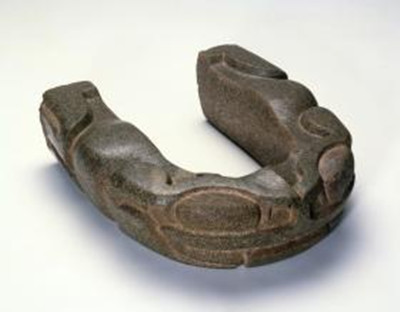They do represent the real yokes that were worn during the ball game, but those real yokes were of perishable materials and they probably, in almost all circumstances, have not survived."
它们象征着比赛中人们真正会使用的腰带。不过那些腰带通常都是用不耐久的材料制成的,无法保存下来。
We know a bit about the Central American ball game because it was quite frequently represented by local artists, who over hundreds of years made sculptures of player figures, and models of pitches, with the public sitting on the walls of the court watching the players. Later European visitors wrote accounts of the game, and a number of stadia built specially for it still survive today. The Spaniards, when they arrived, were amazed by the actual ball that the game was played with. It was made of a substance entirely new to Europeans...rubber. The very first view of a bouncing ball must have been extremely disconcerting-this round object, defying gravity and shooting around in random directions. The Spanish Dominican Friar Diego Duran reported a sighting:
我们对中美洲的球类比赛略知一二,是因为在几百年间,当地艺术家创造了许多跟这种比赛有关的艺术品,如运动员雕像、观众围坐着观看比赛的球场模型等。此外,欧洲来客也曾记录过这些比赛,而且至今在美洲还能找到一些当年专为这些比赛而修建的球场。比赛用球让初到美洲的西班牙人震惊,这是一种对欧洲人来说完全陌生的材质橡胶。一个有弹性的圆球,似乎完全无视地心引力,可以向任何方向弹射: 第一次见到这种物品必定会惊讶万分。西班牙多明我会修道士迭戈?杜兰报道过:
"They call the material of this ball 'hule' (rubber) ... jumping and bouncing are its qualities, upward and downward, to and from. It can exhaust the pursuer running after it before he can catch up with it."
他们把制作这种球的材料称为hule (橡胶)。弹跳性能极佳,能上下左右弹射。追球的人在追到之前,就已经筋疲力尽了。
These balls also became a kind of currency. Spaniards recorded the Aztecs' exacting tribute payments of 16,000 rubber balls. Not many have survived, but excavations and finds made by farmers across Mexico and Central America have turned up a few, as well as hundreds of stone belts like ours-and stone reliefs and sculptures showing players with these 'yokes' or belts around their waists.
橡胶球也变成了一种货币。据西班牙文献记载,他们曾向阿兹特克人强行索要过一万六千个橡胶球作为贡品。留存至今的球并不多,但墨西哥和中美洲的农民挖到过一些,同时还有数百件类似本节中文物的腰带,以及一些石头浮雕和雕像,上面的球员都戴着腰带。



